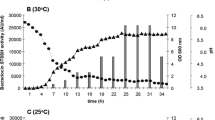Abstract
Boza is a low-pH and low-alcohol cereal-based beverage produced in the Balkan Peninsula. From a total population of 9 × 106 colony-forming units ml−1, four isolates (JW3BZ, JW6BZ, JW11BZ, and JW15BZ) produced bacteriocins active against a broad spectrum of Gram-positive bacteria. Bacteriocin JW15BZ inhibited the growth of Klebsiella pneumoniae. The producer strains were identified as Lactobacillus plantarum (strains JW3BZ and JW6BZ) and L. fermentum (strains JW11BZ and JW15BZ). The spectrum of antimicrobial activity, characteristics, and mode of action of these bacteriocins were compared with bacteriocins previously described for lactic-acid bacteria isolated from boza.




Similar content being viewed by others
Literature Cited
Atrih A, Rekhif N, Moir AJG, Lebrihi A, Lefebvre G (2001) Mode of action, purification and amino acid sequence of plantaricin C19, an anti-Listeria bacteriocin produced by Lactobacillus plantarum C19. Int J Food Microbiol 68:93–109
Chagnaud P, Machinis K, Coutte LA, Marecat A, Mereenier A (2001) Rapid PCR-based procedure to identify lactic-acid bacteria: application to six common Lactobacillus species. J Microbiol Methods 44:139–148
Cheigh C-I, Choi H-J, Park H, Kim S-B, Kook M-C, Kim T-S, et al. (2002) Influence of growth conditions on the production of a nisin-like bacteriocin by Lactococcus lactis subsp. lactis A164 isolated from kimchi. J Biotechnol 95:225–235
Chen H, Hoover DG (2003) Bacteriocins and their food applications. Comp Rev Food Sci Food Safety 2:82–100
De Kwaadsteniet M, Todorov SD, Knoetze H, Dicks LMT (2005) Characterization of a 3 944 Dalton bacteriocin, produced by Enterococcus mundtii ST15, with activity against Gram-positive and Gram-negative bacteria. Int J Food Microbiol 105:433–444
De Man J, Rogosa M, Sharpe E (1960) A medium for the cultivation of lactobacilli. J Appl Bacteriol 23:130–135
De Vuyst L, Vandamme EJ (1994) Bacteriocins of lactic acid bacteria: Microbiology, genetics and applications. London, UK: Blackie Academic and Professional
Felske A, Rheims H, Wolterink A, Stackebrandt E, Akkermans ADL (1997) Ribosome analysis reveals prominent activity of an uncultured member of the class Actinobacteria in grassland soils. Microbiology 143:2983–2989
Gotcheva V, Pandiella SS, Angelov A, Roshkova ZG, Webb C (2000) Microflora identification of the Bulgarian cereal-based fermented beverage boza. Process Biochem 36:127–130
Hancioglu O, Karapinar M (1997) Microflora of Boza, a traditional fermented Turkish beverage. Int J Food Microbiol 35:271–274
Kabadjova P, Gotcheva I, Ivanova I, Dousset X (2000) Investigation of bacteriocin activity of lactic acid bacteria isolated from boza. Biotechnol Biotechnol Equip 14:56–59
Lee NK, Paik HD (2001) Partial characterization of lacticin NK24, a newly identified bacteriocin of Lactococcus lactis NK24 isolated from Jeot-gal. Food Microbiol 18:17–24
Leroy F, De Vuyst L (2004) Lactic acid bacteria as functional starter cultures for the food fermentation industry. Trends Food Sci Technol 15:67–78
Lindgren SW, Dobrogosz WJ (1990) Antagonistic activities of lactic acid bacteria in food and feed fermentations. FEMS Microbiol Rev 87:149–164
Mataragas M, Metaxopoulos J, Galiotou M, Drosinos EH (2003) Influence of pH and temperature on growth and bacteriocin production by Leuconostoc mesenteroides L124 and Lactobacillus curvatus L442. Meat Sci 64:265–271
Métivier A, Boyaval P, Duffes F, Dousset X, Compoint J-P, Marion D (2000) Triton X-114 phase partitioning for the isolation of a pediocin-like bacteriocin from Carnobacterium divergens. Lett Appl Microbiol 30:42–46
Nieto-Lozano JC, Reguera-Useros JI, Peláez-Martínez MC, Hardisson de la Torre JC (2002) Bacteriocinogenic activity from starter cultures used in Spanish meat industry. Meat Sci 62:237–243
Schägger H, Von Jagow G (1987) Tricine-sodium dodecyl sulphate-polyacrylamide gel electrophoresis for the separation of protein in the range from 1 to 100kDa. Anal Biochem 166:368–379
Sneath PHA, Mair NS, Sharpe ME, Holt JG (1986) In: Sneath PHA, Jold JG (eds) Bergey’s manual of systematic bacteriology. Baltimore, MD: Williams and Wilkins; pp 1071–1075
Todorov SD, Danova ST, Van Reenen CA, Meincken M, Dinkova G, Ivanova IV, et al. (2006) Characterization of bacteriocin HV219, produced by Lactococcus lactis subsp. lactis HV219 isolated from human vaginal secretions. J Basic Microbiol 46:226–238
Todorov SD, Dicks LMT (2004) Characterization of mesentericin ST99, a bacteriocin produced by Leuconostoc mesenteroides subsp. dextranicum ST99 isolated from boza. J Ind Microbiol Biotechnol 31:323–329
Todorov SD, Dicks LMT (2005a) Characterization of bacteriocins produced by lactic acid bacteria isolated from spoiled black olives. J Basic Microbiol 45:312–322
Todorov SD, Dicks LMT (2005b) Effect of growth medium on bacteriocin production by Lactobacillus plantarum ST194BZ, a strain isolated from boza. Food Technol Biotechnol 43:165–173
Todorov SD, Dicks LMT (2005c) Pediocin ST18, an anti-listerial bacteriocin produced by Pediococcus pentosaceus ST18 isolated from boza, a traditional cereal beverage from Bulgaria. Process Biochem 40:365–370
Todorov SD, Dicks LMT (2006) Screening for bacteriocin-producing lactic acid bacteria from boza, a traditional cereal beverage from Bulgaria. Comparison of the bacteriocins. Process Biochem 41:11–19
Todorov SD, Van Reenen CA, Dicks LMT (2004) Optimization of bacteriocin production by Lactobacillus plantarum ST13BR, a strain isolated from barley beer. J Gen Appl Microbiol 50:149–157
Verellen TLJ, Bruggeman G, Van Reenen CA, Dicks LMT, Vandamme EJ (1998) Fermentation optimisation of plantaricin 423, a bacteriocin produced by Lactobacillus plantarum 423. J Ferment Bioeng 86:174–179
Yang R, Johnson M, Ray B (1992) A novel method to extract large amounts of bacteriocins from lactic acid bacteria. Appl Environ Microbiol 58:3355–3359
Zorba M, Hancioglu O, Genc M, Karapinar M, Ova G (2003) The use of starter cultures in the fermentation of boza, a traditional Turkish beverage. Process Biochem 38:1405–1411
Author information
Authors and Affiliations
Corresponding author
Rights and permissions
About this article
Cite this article
von Mollendorff, J., Todorov, S. & Dicks, L. Comparison of Bacteriocins Produced by Lactic-Acid Bacteria Isolated from Boza, a Cereal-Based Fermented Beverage from the Balkan Peninsula. Curr Microbiol 53, 209–216 (2006). https://doi.org/10.1007/s00284-006-0075-9
Received:
Accepted:
Published:
Issue Date:
DOI: https://doi.org/10.1007/s00284-006-0075-9




